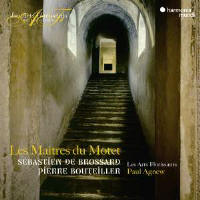Texte paru dans: / Appeared in: |
|
|
Outil de traduction ~ (Très approximatif) |
|
|
Reviewer: Bertil
van Boer
During the ancient régime
of Louis XIV and XV, composers in Paris were active in providing both the
court and church with impressive works that were solemn and festive. Of
course, the court favored opera in the fashion of Jean-Baptiste Lully, with
its own stable of court musicians beyond Lully’s demise in 1687 being ever
more aware of the pomp and circumstance that characterized Versailles. As
instrumental music grew in fashion, the Couperins and others exercised their
talents in developing works that were both entertaining and pedagogical,
publishing them for public consumption. Church music, on the other hand,
seems to have taken a back seat. Marc-Antoine Charpentier, for example,
lavished his considerable abilities on sacred music, but everyone knew he
really wanted to compose for the stage. The church provided him with a day
job, but commissions beyond gave him prestige and renown. Given the
centrality of the French court, it is not unexpected that composers from
outside the capital were drawn there, but had to be satisfied with lesser
positions, often in the chapels around town. These posts offered
remuneration, allowing them to follow down that often tortuous path toward
recognition.
Of these, perhaps the least
known is André Raison (c. 1650–1719), who probably hailed from Nanterre, not
far from Paris. Although he gained a reputation as a fine organist, perhaps
the best in France, he remained satisfied with a post at the Church of St.
Genevieve for the bulk of his life. He was known for publishing two books of
organ music, one in 1688 and the second in 1714, both dedicated to the Royal
Court, but he led a modest if comfortable life. Here, his two Kyrie
intonations are presented. Both are brief, succinct, and simple, a
reflection on his personal position. Not so Pierre Bouteiller (c. 1655–c.
1717), who was the director of church music at Châlons-sur-Marne. He had
come there from Troyes, but a chance meeting with Sébastien de Brossard
(1655–1730) apparently led to him attempting to improve his lot by moving to
Paris. There he gained a reputation not as a composer, but rather as an
instrumentalist, and eventually he obtained a post with Philip V, the
Bourbon King of Spain. Returning to France a few years later, he vanishes
from history about 1717. His last work was as a private teacher and
musician. Little of his music has survived—a bare 13 small motets and a
Requiem Mass—and that only because Brossard was able to obtain them during
their brief encounter. (There is no doubt that he wrote much other music
which has not survived.) These were recorded on Atma Baroque by Les Voix
Humaines back in 2005, but here the Requiem serves to fill out the various
Brossard pieces in a program from this time. The Mass is quite harmonious
and outlines the text with broad sweeps of choral grandeur. For example, the
Domine Jesu Christe begins with a simple duet declamation before suddenly
expanding out into a gigantic homophonic chorus. The lines are of limited
range, but the voicing is spaced to create a large-scale resonance. The Lux
aeterna is gentle and flowing, with the same full-bodied ambience, but here
with the occasional echo effects. It is a solemn and yet powerful work.
Brossard’s music is better
known, though his real claim to fame rests upon his musical dictionary
published in 1701. Originally from Caen, he arrived in Paris in 1678 and
spent the next two decades or so in or around the city. In 1687, the
composer, a priest, was sent by Louis XIV to Strasbourg on a religious
mission, and over the next decade he wavered between Paris and Alsace, all
the while publishing several collections of works. He failed to obtain a
musical post at Sainte-Chapelle in 1698 and was passed over by Charpentier.
Instead, he retired to Meaux, where he spent the remainder of his life.
Brossard’s music is typical of
the French fashion of the time, generally for solo voices with choral
interludes, all held together by a basse continue. The Miserere is strophic,
with an intonation by the solo soprano followed by a choral refrain. The
larger Stabat Mater, on the other hand, is a more expansive work. The choral
portions are large and expressive, while the solo work moves at a sedate
pace. For instance, the Cujus animam has a flowing bass, succeeded by a
solemn and lyrical quartet, O quam tristis. In a major key, it relies upon
suspensions and a kaleidoscopic texture to impart the mood. The Fa cut
ardeat is more virtuoso, and here the continuo moves right along in this
short exposition. The final fugue at Quando corpus both ornaments the final
line and provides a suitably complex finale. The performance by Les Arts Florissants is excellent. The tempos keep the music lively, and conductor Paul Agnew knows how to use the often sedate phrasing to enliven the lines. The continuo playing is wonderfully supportive, though never intrusive, and the textures are used judiciously to give these works depth and solemnity. In short, this is one disc that is well worth obtaining; it demonstrates the quality and complexity of sacred music of the French Baroque without undue pomp and circumstance. | |
|
|
|
|
Cliquez l'un ou l'autre
bouton pour découvrir bien d'autres critiques de CD |
|




